BS4S16 Leadership & Management Theories: Nissan Motor Corporation
VerifiedAdded on 2023/04/22
|30
|8641
|299
Report
AI Summary
This report provides a critical evaluation of the application of leadership and management theories, focusing on Nissan Motor Corporation and the leadership of Carlos Ghosn. It begins with an introduction to leadership and management theories, highlighting different leadership styles and management approaches. The report then delves into a contextual discussion of the broader development of these theories, followed by a critical evaluation of specific theories such as the Great Man Theory and Trait Theory, assessing their relevance and limitations. The analysis extends to how these theories were applied in Nissan Motor Corporation, particularly during Carlos Ghosn's tenure, evaluating the fit between theory and practice. The report concludes by summarizing the key findings and offering a commentary on the effectiveness of the leadership and management strategies employed at Nissan. This detailed analysis provides valuable insights into the practical application of theoretical concepts in a real-world organizational setting.
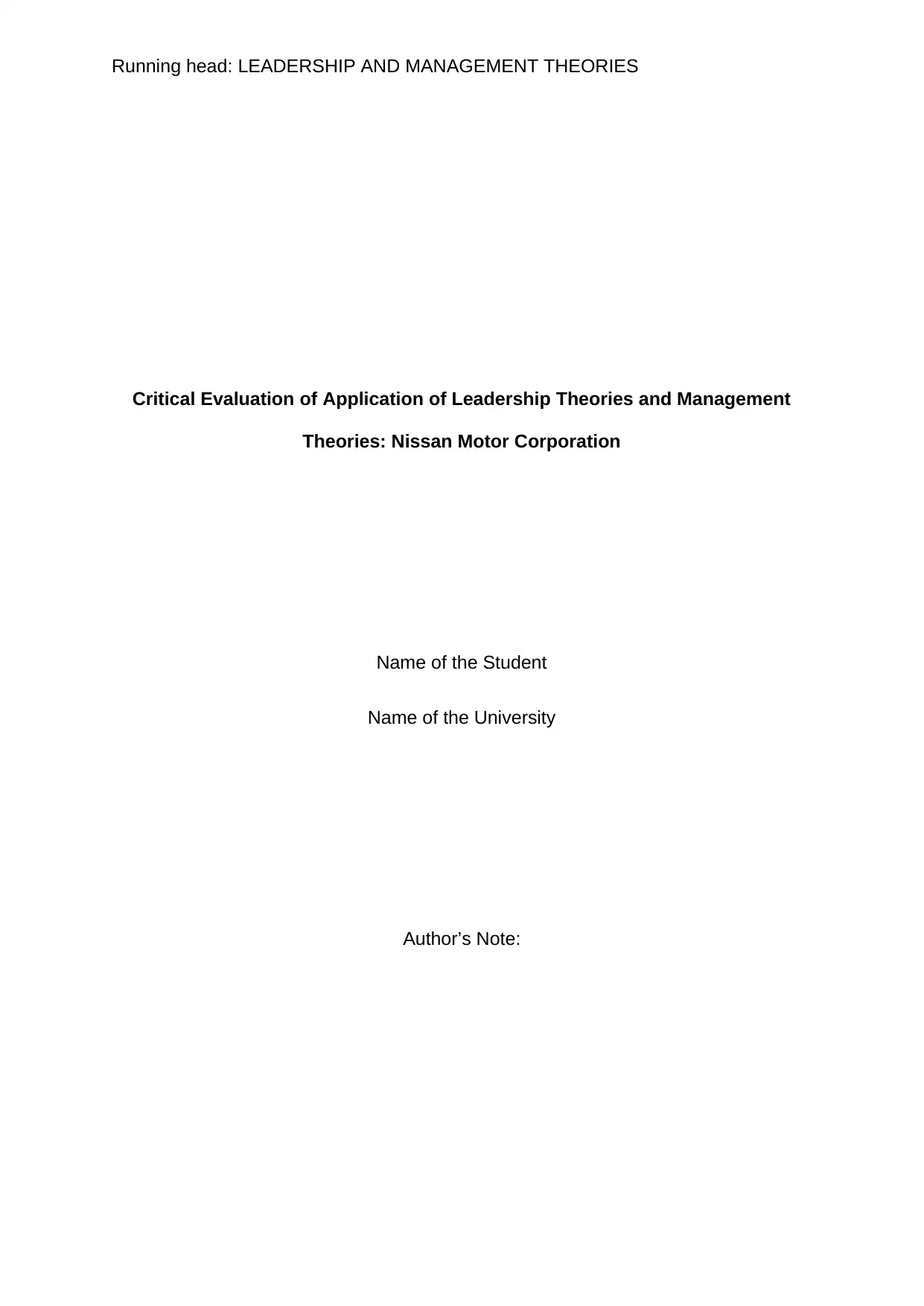
Running head: LEADERSHIP AND MANAGEMENT THEORIES
Critical Evaluation of Application of Leadership Theories and Management
Theories: Nissan Motor Corporation
Name of the Student
Name of the University
Author’s Note:
Critical Evaluation of Application of Leadership Theories and Management
Theories: Nissan Motor Corporation
Name of the Student
Name of the University
Author’s Note:
Paraphrase This Document
Need a fresh take? Get an instant paraphrase of this document with our AI Paraphraser
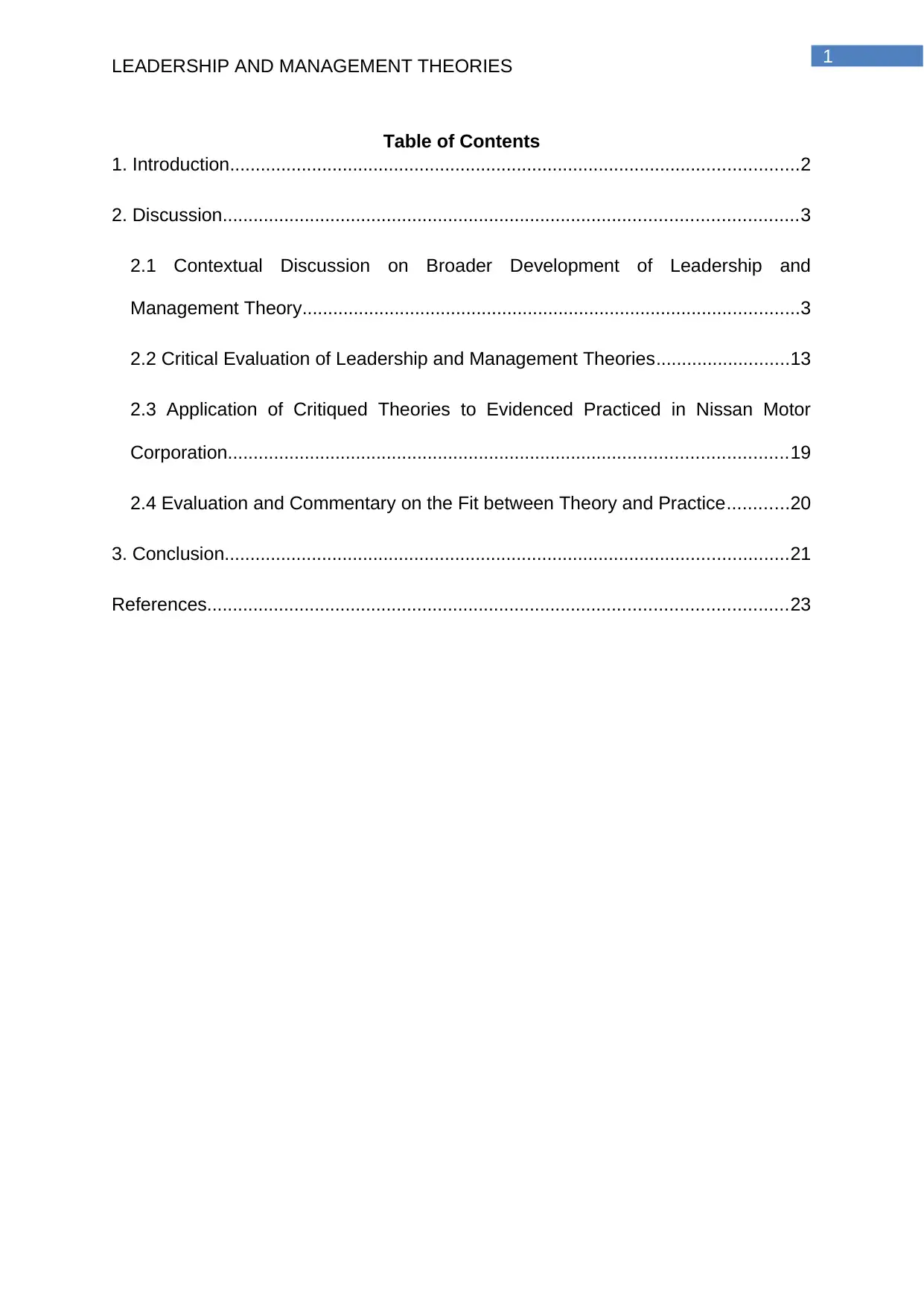
1
LEADERSHIP AND MANAGEMENT THEORIES
Table of Contents
1. Introduction...............................................................................................................2
2. Discussion................................................................................................................3
2.1 Contextual Discussion on Broader Development of Leadership and
Management Theory.................................................................................................3
2.2 Critical Evaluation of Leadership and Management Theories..........................13
2.3 Application of Critiqued Theories to Evidenced Practiced in Nissan Motor
Corporation.............................................................................................................19
2.4 Evaluation and Commentary on the Fit between Theory and Practice............20
3. Conclusion..............................................................................................................21
References.................................................................................................................23
LEADERSHIP AND MANAGEMENT THEORIES
Table of Contents
1. Introduction...............................................................................................................2
2. Discussion................................................................................................................3
2.1 Contextual Discussion on Broader Development of Leadership and
Management Theory.................................................................................................3
2.2 Critical Evaluation of Leadership and Management Theories..........................13
2.3 Application of Critiqued Theories to Evidenced Practiced in Nissan Motor
Corporation.............................................................................................................19
2.4 Evaluation and Commentary on the Fit between Theory and Practice............20
3. Conclusion..............................................................................................................21
References.................................................................................................................23
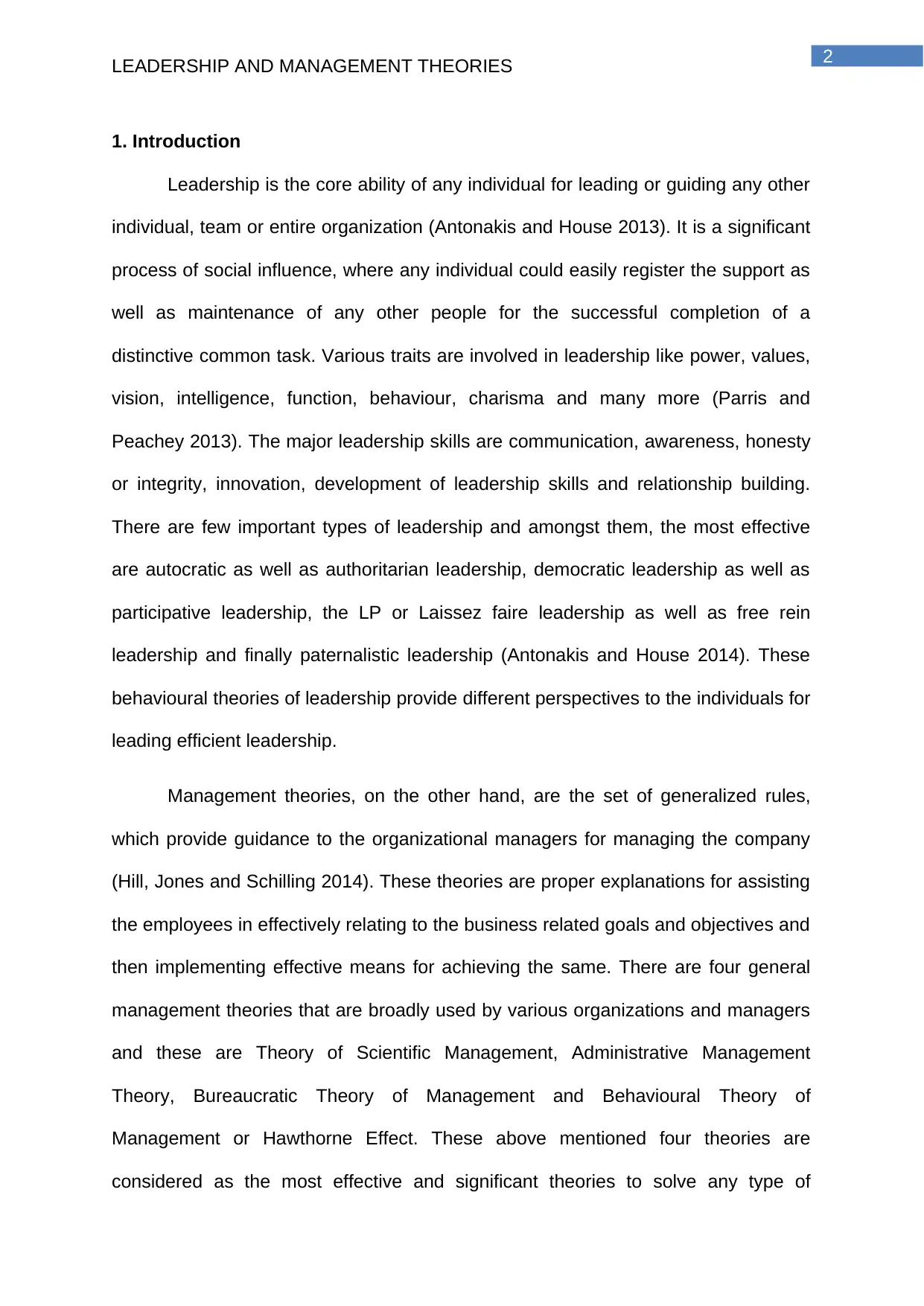
2
LEADERSHIP AND MANAGEMENT THEORIES
1. Introduction
Leadership is the core ability of any individual for leading or guiding any other
individual, team or entire organization (Antonakis and House 2013). It is a significant
process of social influence, where any individual could easily register the support as
well as maintenance of any other people for the successful completion of a
distinctive common task. Various traits are involved in leadership like power, values,
vision, intelligence, function, behaviour, charisma and many more (Parris and
Peachey 2013). The major leadership skills are communication, awareness, honesty
or integrity, innovation, development of leadership skills and relationship building.
There are few important types of leadership and amongst them, the most effective
are autocratic as well as authoritarian leadership, democratic leadership as well as
participative leadership, the LP or Laissez faire leadership as well as free rein
leadership and finally paternalistic leadership (Antonakis and House 2014). These
behavioural theories of leadership provide different perspectives to the individuals for
leading efficient leadership.
Management theories, on the other hand, are the set of generalized rules,
which provide guidance to the organizational managers for managing the company
(Hill, Jones and Schilling 2014). These theories are proper explanations for assisting
the employees in effectively relating to the business related goals and objectives and
then implementing effective means for achieving the same. There are four general
management theories that are broadly used by various organizations and managers
and these are Theory of Scientific Management, Administrative Management
Theory, Bureaucratic Theory of Management and Behavioural Theory of
Management or Hawthorne Effect. These above mentioned four theories are
considered as the most effective and significant theories to solve any type of
LEADERSHIP AND MANAGEMENT THEORIES
1. Introduction
Leadership is the core ability of any individual for leading or guiding any other
individual, team or entire organization (Antonakis and House 2013). It is a significant
process of social influence, where any individual could easily register the support as
well as maintenance of any other people for the successful completion of a
distinctive common task. Various traits are involved in leadership like power, values,
vision, intelligence, function, behaviour, charisma and many more (Parris and
Peachey 2013). The major leadership skills are communication, awareness, honesty
or integrity, innovation, development of leadership skills and relationship building.
There are few important types of leadership and amongst them, the most effective
are autocratic as well as authoritarian leadership, democratic leadership as well as
participative leadership, the LP or Laissez faire leadership as well as free rein
leadership and finally paternalistic leadership (Antonakis and House 2014). These
behavioural theories of leadership provide different perspectives to the individuals for
leading efficient leadership.
Management theories, on the other hand, are the set of generalized rules,
which provide guidance to the organizational managers for managing the company
(Hill, Jones and Schilling 2014). These theories are proper explanations for assisting
the employees in effectively relating to the business related goals and objectives and
then implementing effective means for achieving the same. There are four general
management theories that are broadly used by various organizations and managers
and these are Theory of Scientific Management, Administrative Management
Theory, Bureaucratic Theory of Management and Behavioural Theory of
Management or Hawthorne Effect. These above mentioned four theories are
considered as the most effective and significant theories to solve any type of
⊘ This is a preview!⊘
Do you want full access?
Subscribe today to unlock all pages.

Trusted by 1+ million students worldwide
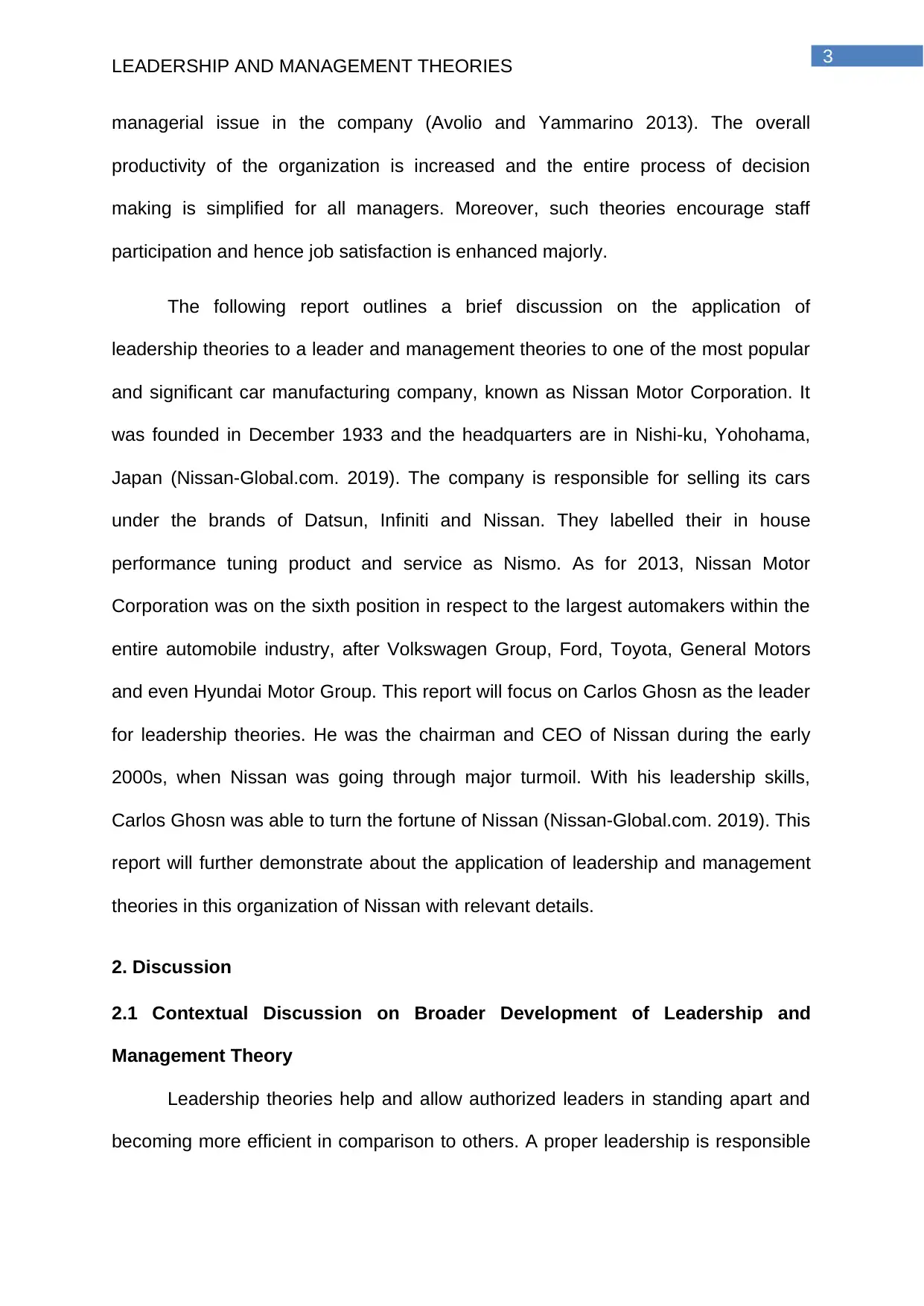
3
LEADERSHIP AND MANAGEMENT THEORIES
managerial issue in the company (Avolio and Yammarino 2013). The overall
productivity of the organization is increased and the entire process of decision
making is simplified for all managers. Moreover, such theories encourage staff
participation and hence job satisfaction is enhanced majorly.
The following report outlines a brief discussion on the application of
leadership theories to a leader and management theories to one of the most popular
and significant car manufacturing company, known as Nissan Motor Corporation. It
was founded in December 1933 and the headquarters are in Nishi-ku, Yohohama,
Japan (Nissan-Global.com. 2019). The company is responsible for selling its cars
under the brands of Datsun, Infiniti and Nissan. They labelled their in house
performance tuning product and service as Nismo. As for 2013, Nissan Motor
Corporation was on the sixth position in respect to the largest automakers within the
entire automobile industry, after Volkswagen Group, Ford, Toyota, General Motors
and even Hyundai Motor Group. This report will focus on Carlos Ghosn as the leader
for leadership theories. He was the chairman and CEO of Nissan during the early
2000s, when Nissan was going through major turmoil. With his leadership skills,
Carlos Ghosn was able to turn the fortune of Nissan (Nissan-Global.com. 2019). This
report will further demonstrate about the application of leadership and management
theories in this organization of Nissan with relevant details.
2. Discussion
2.1 Contextual Discussion on Broader Development of Leadership and
Management Theory
Leadership theories help and allow authorized leaders in standing apart and
becoming more efficient in comparison to others. A proper leadership is responsible
LEADERSHIP AND MANAGEMENT THEORIES
managerial issue in the company (Avolio and Yammarino 2013). The overall
productivity of the organization is increased and the entire process of decision
making is simplified for all managers. Moreover, such theories encourage staff
participation and hence job satisfaction is enhanced majorly.
The following report outlines a brief discussion on the application of
leadership theories to a leader and management theories to one of the most popular
and significant car manufacturing company, known as Nissan Motor Corporation. It
was founded in December 1933 and the headquarters are in Nishi-ku, Yohohama,
Japan (Nissan-Global.com. 2019). The company is responsible for selling its cars
under the brands of Datsun, Infiniti and Nissan. They labelled their in house
performance tuning product and service as Nismo. As for 2013, Nissan Motor
Corporation was on the sixth position in respect to the largest automakers within the
entire automobile industry, after Volkswagen Group, Ford, Toyota, General Motors
and even Hyundai Motor Group. This report will focus on Carlos Ghosn as the leader
for leadership theories. He was the chairman and CEO of Nissan during the early
2000s, when Nissan was going through major turmoil. With his leadership skills,
Carlos Ghosn was able to turn the fortune of Nissan (Nissan-Global.com. 2019). This
report will further demonstrate about the application of leadership and management
theories in this organization of Nissan with relevant details.
2. Discussion
2.1 Contextual Discussion on Broader Development of Leadership and
Management Theory
Leadership theories help and allow authorized leaders in standing apart and
becoming more efficient in comparison to others. A proper leadership is responsible
Paraphrase This Document
Need a fresh take? Get an instant paraphrase of this document with our AI Paraphraser
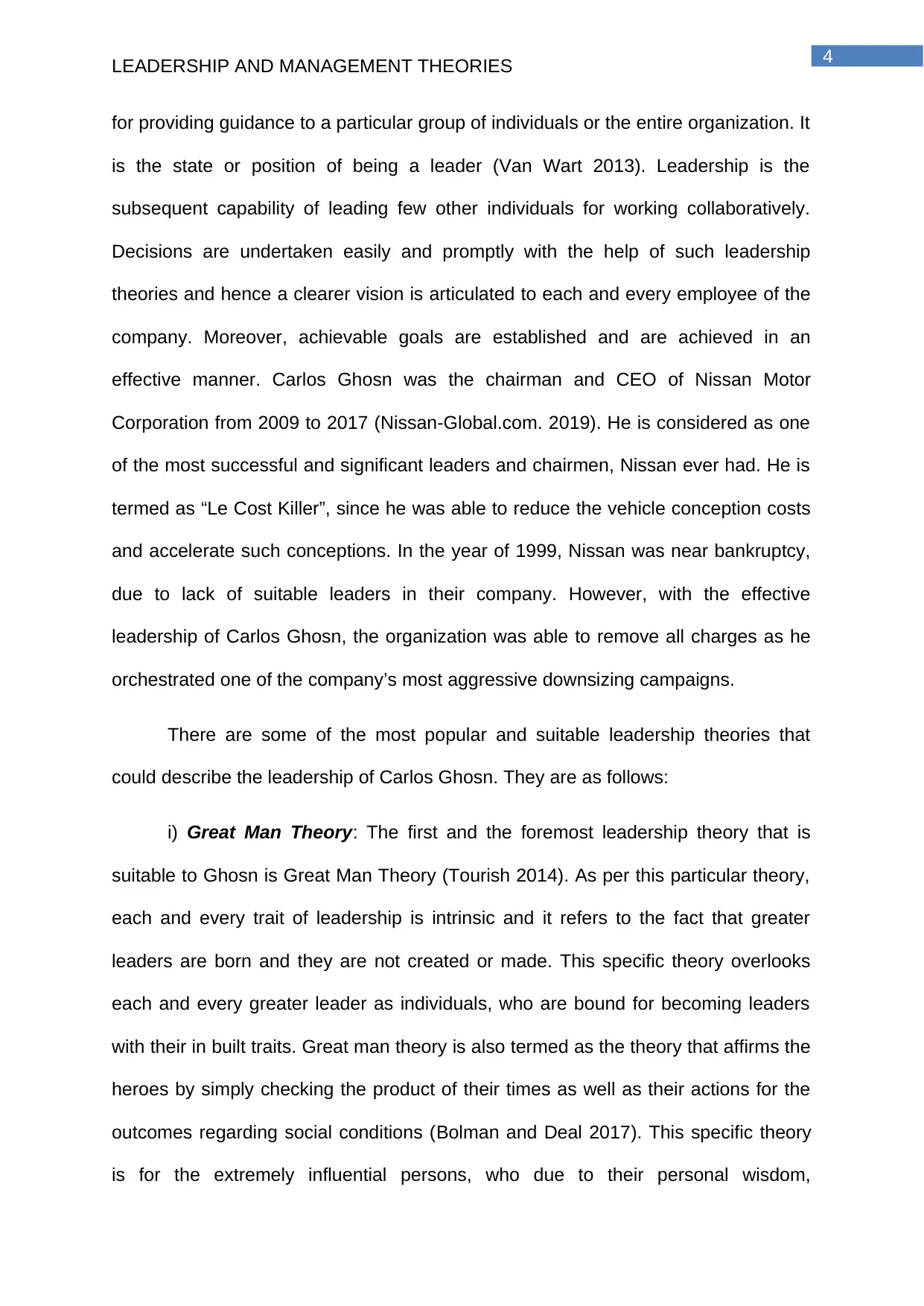
4
LEADERSHIP AND MANAGEMENT THEORIES
for providing guidance to a particular group of individuals or the entire organization. It
is the state or position of being a leader (Van Wart 2013). Leadership is the
subsequent capability of leading few other individuals for working collaboratively.
Decisions are undertaken easily and promptly with the help of such leadership
theories and hence a clearer vision is articulated to each and every employee of the
company. Moreover, achievable goals are established and are achieved in an
effective manner. Carlos Ghosn was the chairman and CEO of Nissan Motor
Corporation from 2009 to 2017 (Nissan-Global.com. 2019). He is considered as one
of the most successful and significant leaders and chairmen, Nissan ever had. He is
termed as “Le Cost Killer”, since he was able to reduce the vehicle conception costs
and accelerate such conceptions. In the year of 1999, Nissan was near bankruptcy,
due to lack of suitable leaders in their company. However, with the effective
leadership of Carlos Ghosn, the organization was able to remove all charges as he
orchestrated one of the company’s most aggressive downsizing campaigns.
There are some of the most popular and suitable leadership theories that
could describe the leadership of Carlos Ghosn. They are as follows:
i) Great Man Theory: The first and the foremost leadership theory that is
suitable to Ghosn is Great Man Theory (Tourish 2014). As per this particular theory,
each and every trait of leadership is intrinsic and it refers to the fact that greater
leaders are born and they are not created or made. This specific theory overlooks
each and every greater leader as individuals, who are bound for becoming leaders
with their in built traits. Great man theory is also termed as the theory that affirms the
heroes by simply checking the product of their times as well as their actions for the
outcomes regarding social conditions (Bolman and Deal 2017). This specific theory
is for the extremely influential persons, who due to their personal wisdom,
LEADERSHIP AND MANAGEMENT THEORIES
for providing guidance to a particular group of individuals or the entire organization. It
is the state or position of being a leader (Van Wart 2013). Leadership is the
subsequent capability of leading few other individuals for working collaboratively.
Decisions are undertaken easily and promptly with the help of such leadership
theories and hence a clearer vision is articulated to each and every employee of the
company. Moreover, achievable goals are established and are achieved in an
effective manner. Carlos Ghosn was the chairman and CEO of Nissan Motor
Corporation from 2009 to 2017 (Nissan-Global.com. 2019). He is considered as one
of the most successful and significant leaders and chairmen, Nissan ever had. He is
termed as “Le Cost Killer”, since he was able to reduce the vehicle conception costs
and accelerate such conceptions. In the year of 1999, Nissan was near bankruptcy,
due to lack of suitable leaders in their company. However, with the effective
leadership of Carlos Ghosn, the organization was able to remove all charges as he
orchestrated one of the company’s most aggressive downsizing campaigns.
There are some of the most popular and suitable leadership theories that
could describe the leadership of Carlos Ghosn. They are as follows:
i) Great Man Theory: The first and the foremost leadership theory that is
suitable to Ghosn is Great Man Theory (Tourish 2014). As per this particular theory,
each and every trait of leadership is intrinsic and it refers to the fact that greater
leaders are born and they are not created or made. This specific theory overlooks
each and every greater leader as individuals, who are bound for becoming leaders
with their in built traits. Great man theory is also termed as the theory that affirms the
heroes by simply checking the product of their times as well as their actions for the
outcomes regarding social conditions (Bolman and Deal 2017). This specific theory
is for the extremely influential persons, who due to their personal wisdom,
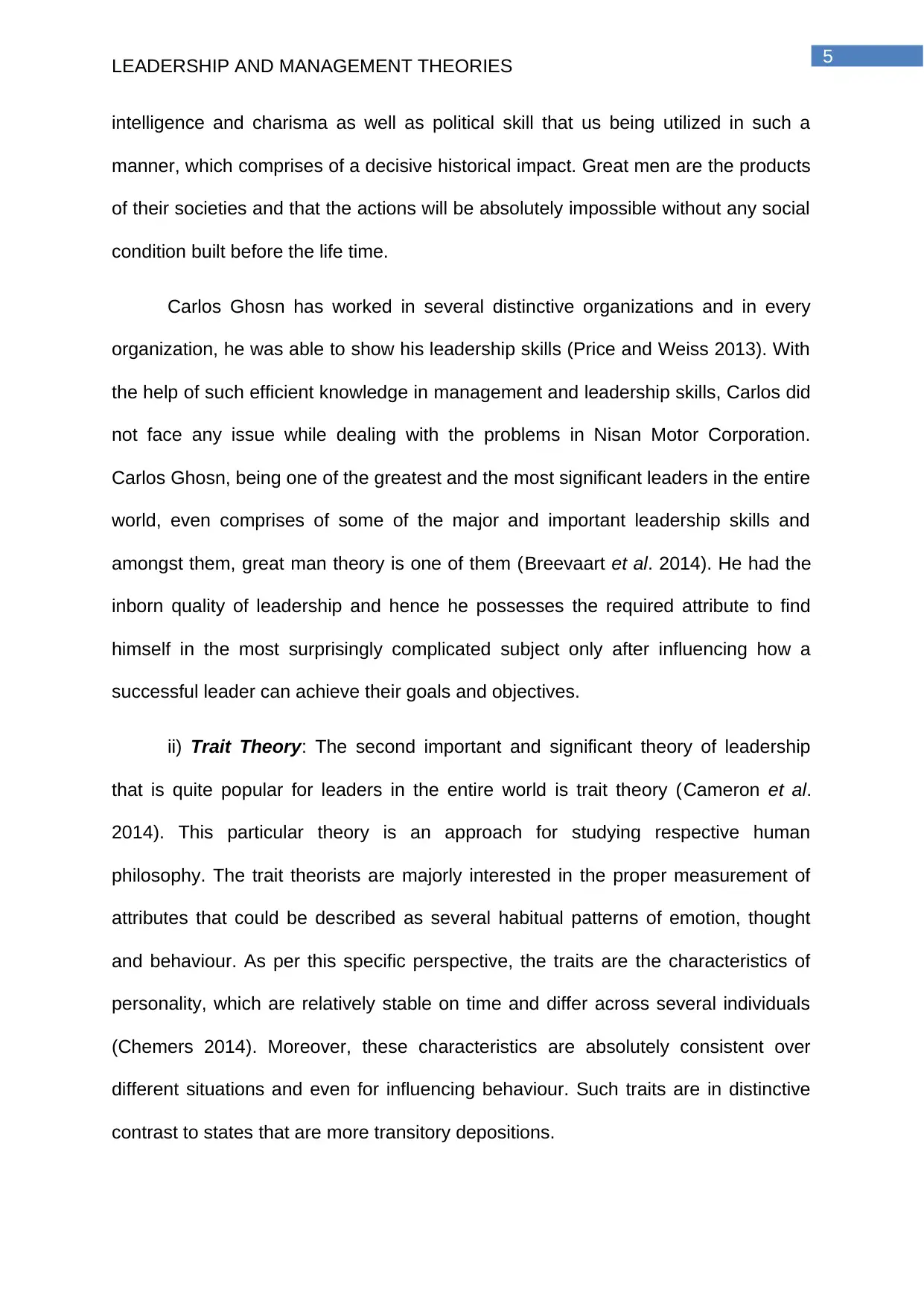
5
LEADERSHIP AND MANAGEMENT THEORIES
intelligence and charisma as well as political skill that us being utilized in such a
manner, which comprises of a decisive historical impact. Great men are the products
of their societies and that the actions will be absolutely impossible without any social
condition built before the life time.
Carlos Ghosn has worked in several distinctive organizations and in every
organization, he was able to show his leadership skills (Price and Weiss 2013). With
the help of such efficient knowledge in management and leadership skills, Carlos did
not face any issue while dealing with the problems in Nisan Motor Corporation.
Carlos Ghosn, being one of the greatest and the most significant leaders in the entire
world, even comprises of some of the major and important leadership skills and
amongst them, great man theory is one of them (Breevaart et al. 2014). He had the
inborn quality of leadership and hence he possesses the required attribute to find
himself in the most surprisingly complicated subject only after influencing how a
successful leader can achieve their goals and objectives.
ii) Trait Theory: The second important and significant theory of leadership
that is quite popular for leaders in the entire world is trait theory (Cameron et al.
2014). This particular theory is an approach for studying respective human
philosophy. The trait theorists are majorly interested in the proper measurement of
attributes that could be described as several habitual patterns of emotion, thought
and behaviour. As per this specific perspective, the traits are the characteristics of
personality, which are relatively stable on time and differ across several individuals
(Chemers 2014). Moreover, these characteristics are absolutely consistent over
different situations and even for influencing behaviour. Such traits are in distinctive
contrast to states that are more transitory depositions.
LEADERSHIP AND MANAGEMENT THEORIES
intelligence and charisma as well as political skill that us being utilized in such a
manner, which comprises of a decisive historical impact. Great men are the products
of their societies and that the actions will be absolutely impossible without any social
condition built before the life time.
Carlos Ghosn has worked in several distinctive organizations and in every
organization, he was able to show his leadership skills (Price and Weiss 2013). With
the help of such efficient knowledge in management and leadership skills, Carlos did
not face any issue while dealing with the problems in Nisan Motor Corporation.
Carlos Ghosn, being one of the greatest and the most significant leaders in the entire
world, even comprises of some of the major and important leadership skills and
amongst them, great man theory is one of them (Breevaart et al. 2014). He had the
inborn quality of leadership and hence he possesses the required attribute to find
himself in the most surprisingly complicated subject only after influencing how a
successful leader can achieve their goals and objectives.
ii) Trait Theory: The second important and significant theory of leadership
that is quite popular for leaders in the entire world is trait theory (Cameron et al.
2014). This particular theory is an approach for studying respective human
philosophy. The trait theorists are majorly interested in the proper measurement of
attributes that could be described as several habitual patterns of emotion, thought
and behaviour. As per this specific perspective, the traits are the characteristics of
personality, which are relatively stable on time and differ across several individuals
(Chemers 2014). Moreover, these characteristics are absolutely consistent over
different situations and even for influencing behaviour. Such traits are in distinctive
contrast to states that are more transitory depositions.
⊘ This is a preview!⊘
Do you want full access?
Subscribe today to unlock all pages.

Trusted by 1+ million students worldwide
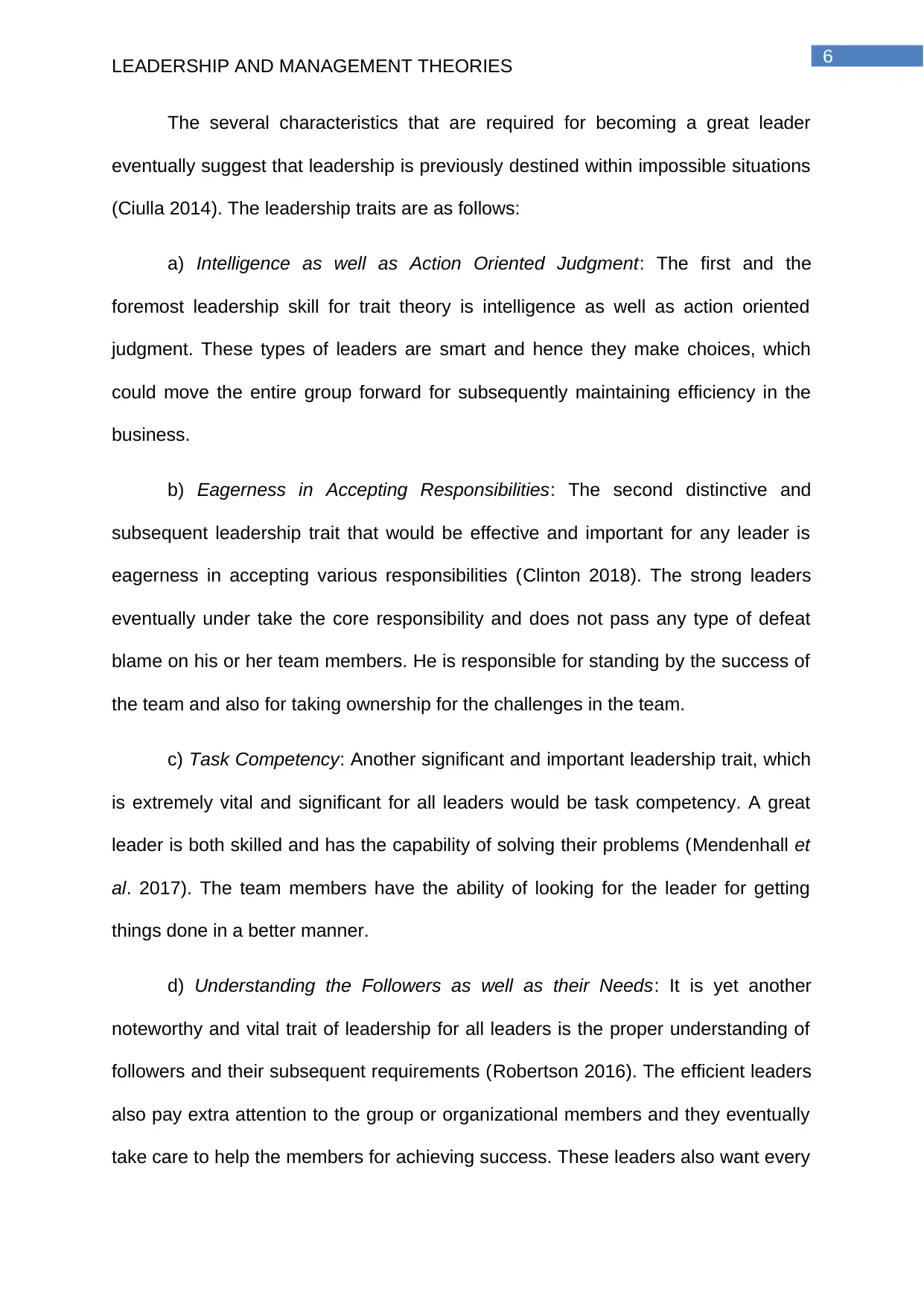
6
LEADERSHIP AND MANAGEMENT THEORIES
The several characteristics that are required for becoming a great leader
eventually suggest that leadership is previously destined within impossible situations
(Ciulla 2014). The leadership traits are as follows:
a) Intelligence as well as Action Oriented Judgment: The first and the
foremost leadership skill for trait theory is intelligence as well as action oriented
judgment. These types of leaders are smart and hence they make choices, which
could move the entire group forward for subsequently maintaining efficiency in the
business.
b) Eagerness in Accepting Responsibilities: The second distinctive and
subsequent leadership trait that would be effective and important for any leader is
eagerness in accepting various responsibilities (Clinton 2018). The strong leaders
eventually under take the core responsibility and does not pass any type of defeat
blame on his or her team members. He is responsible for standing by the success of
the team and also for taking ownership for the challenges in the team.
c) Task Competency: Another significant and important leadership trait, which
is extremely vital and significant for all leaders would be task competency. A great
leader is both skilled and has the capability of solving their problems (Mendenhall et
al. 2017). The team members have the ability of looking for the leader for getting
things done in a better manner.
d) Understanding the Followers as well as their Needs: It is yet another
noteworthy and vital trait of leadership for all leaders is the proper understanding of
followers and their subsequent requirements (Robertson 2016). The efficient leaders
also pay extra attention to the group or organizational members and they eventually
take care to help the members for achieving success. These leaders also want every
LEADERSHIP AND MANAGEMENT THEORIES
The several characteristics that are required for becoming a great leader
eventually suggest that leadership is previously destined within impossible situations
(Ciulla 2014). The leadership traits are as follows:
a) Intelligence as well as Action Oriented Judgment: The first and the
foremost leadership skill for trait theory is intelligence as well as action oriented
judgment. These types of leaders are smart and hence they make choices, which
could move the entire group forward for subsequently maintaining efficiency in the
business.
b) Eagerness in Accepting Responsibilities: The second distinctive and
subsequent leadership trait that would be effective and important for any leader is
eagerness in accepting various responsibilities (Clinton 2018). The strong leaders
eventually under take the core responsibility and does not pass any type of defeat
blame on his or her team members. He is responsible for standing by the success of
the team and also for taking ownership for the challenges in the team.
c) Task Competency: Another significant and important leadership trait, which
is extremely vital and significant for all leaders would be task competency. A great
leader is both skilled and has the capability of solving their problems (Mendenhall et
al. 2017). The team members have the ability of looking for the leader for getting
things done in a better manner.
d) Understanding the Followers as well as their Needs: It is yet another
noteworthy and vital trait of leadership for all leaders is the proper understanding of
followers and their subsequent requirements (Robertson 2016). The efficient leaders
also pay extra attention to the group or organizational members and they eventually
take care to help the members for achieving success. These leaders also want every
Paraphrase This Document
Need a fresh take? Get an instant paraphrase of this document with our AI Paraphraser
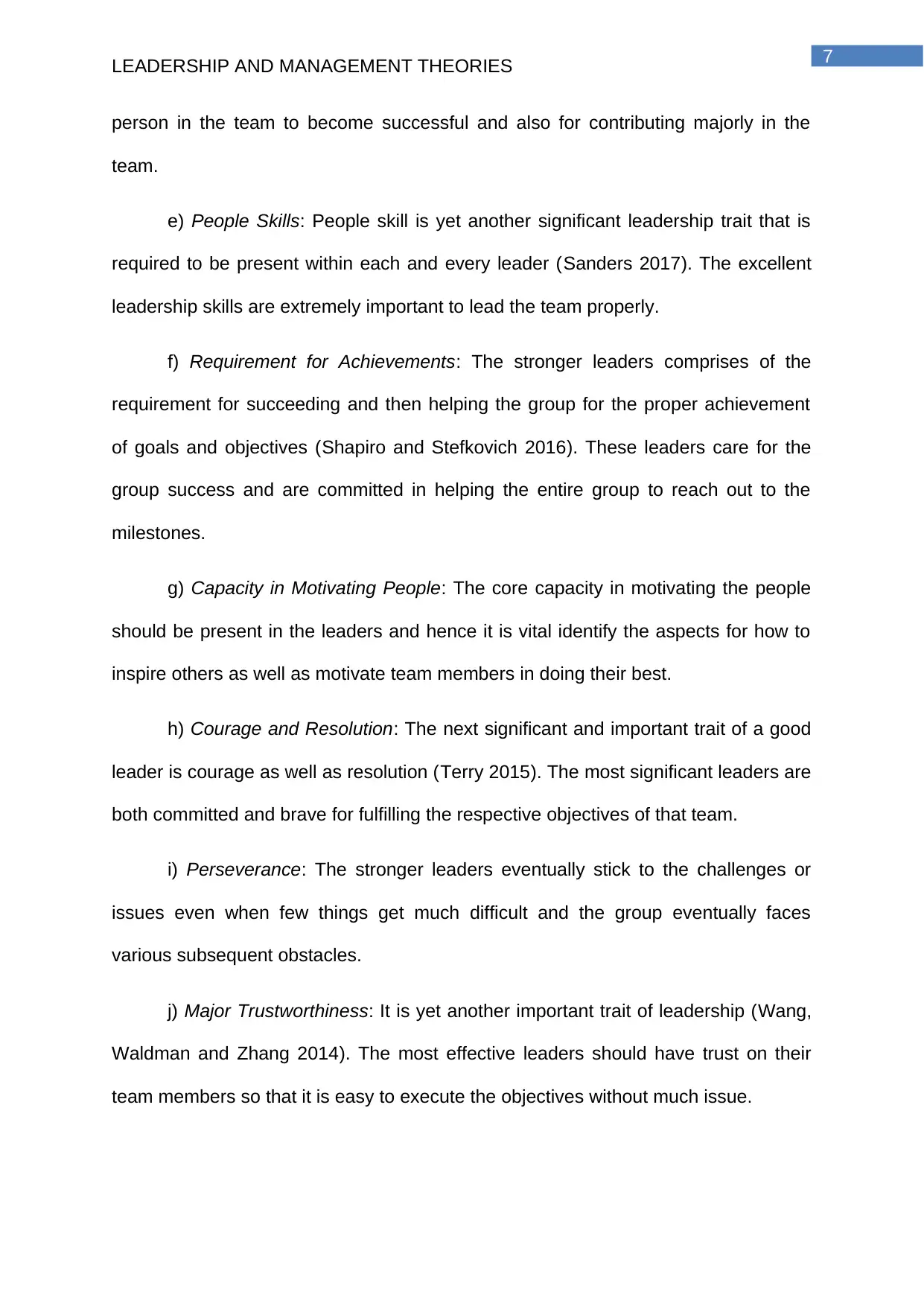
7
LEADERSHIP AND MANAGEMENT THEORIES
person in the team to become successful and also for contributing majorly in the
team.
e) People Skills: People skill is yet another significant leadership trait that is
required to be present within each and every leader (Sanders 2017). The excellent
leadership skills are extremely important to lead the team properly.
f) Requirement for Achievements: The stronger leaders comprises of the
requirement for succeeding and then helping the group for the proper achievement
of goals and objectives (Shapiro and Stefkovich 2016). These leaders care for the
group success and are committed in helping the entire group to reach out to the
milestones.
g) Capacity in Motivating People: The core capacity in motivating the people
should be present in the leaders and hence it is vital identify the aspects for how to
inspire others as well as motivate team members in doing their best.
h) Courage and Resolution: The next significant and important trait of a good
leader is courage as well as resolution (Terry 2015). The most significant leaders are
both committed and brave for fulfilling the respective objectives of that team.
i) Perseverance: The stronger leaders eventually stick to the challenges or
issues even when few things get much difficult and the group eventually faces
various subsequent obstacles.
j) Major Trustworthiness: It is yet another important trait of leadership (Wang,
Waldman and Zhang 2014). The most effective leaders should have trust on their
team members so that it is easy to execute the objectives without much issue.
LEADERSHIP AND MANAGEMENT THEORIES
person in the team to become successful and also for contributing majorly in the
team.
e) People Skills: People skill is yet another significant leadership trait that is
required to be present within each and every leader (Sanders 2017). The excellent
leadership skills are extremely important to lead the team properly.
f) Requirement for Achievements: The stronger leaders comprises of the
requirement for succeeding and then helping the group for the proper achievement
of goals and objectives (Shapiro and Stefkovich 2016). These leaders care for the
group success and are committed in helping the entire group to reach out to the
milestones.
g) Capacity in Motivating People: The core capacity in motivating the people
should be present in the leaders and hence it is vital identify the aspects for how to
inspire others as well as motivate team members in doing their best.
h) Courage and Resolution: The next significant and important trait of a good
leader is courage as well as resolution (Terry 2015). The most significant leaders are
both committed and brave for fulfilling the respective objectives of that team.
i) Perseverance: The stronger leaders eventually stick to the challenges or
issues even when few things get much difficult and the group eventually faces
various subsequent obstacles.
j) Major Trustworthiness: It is yet another important trait of leadership (Wang,
Waldman and Zhang 2014). The most effective leaders should have trust on their
team members so that it is easy to execute the objectives without much issue.
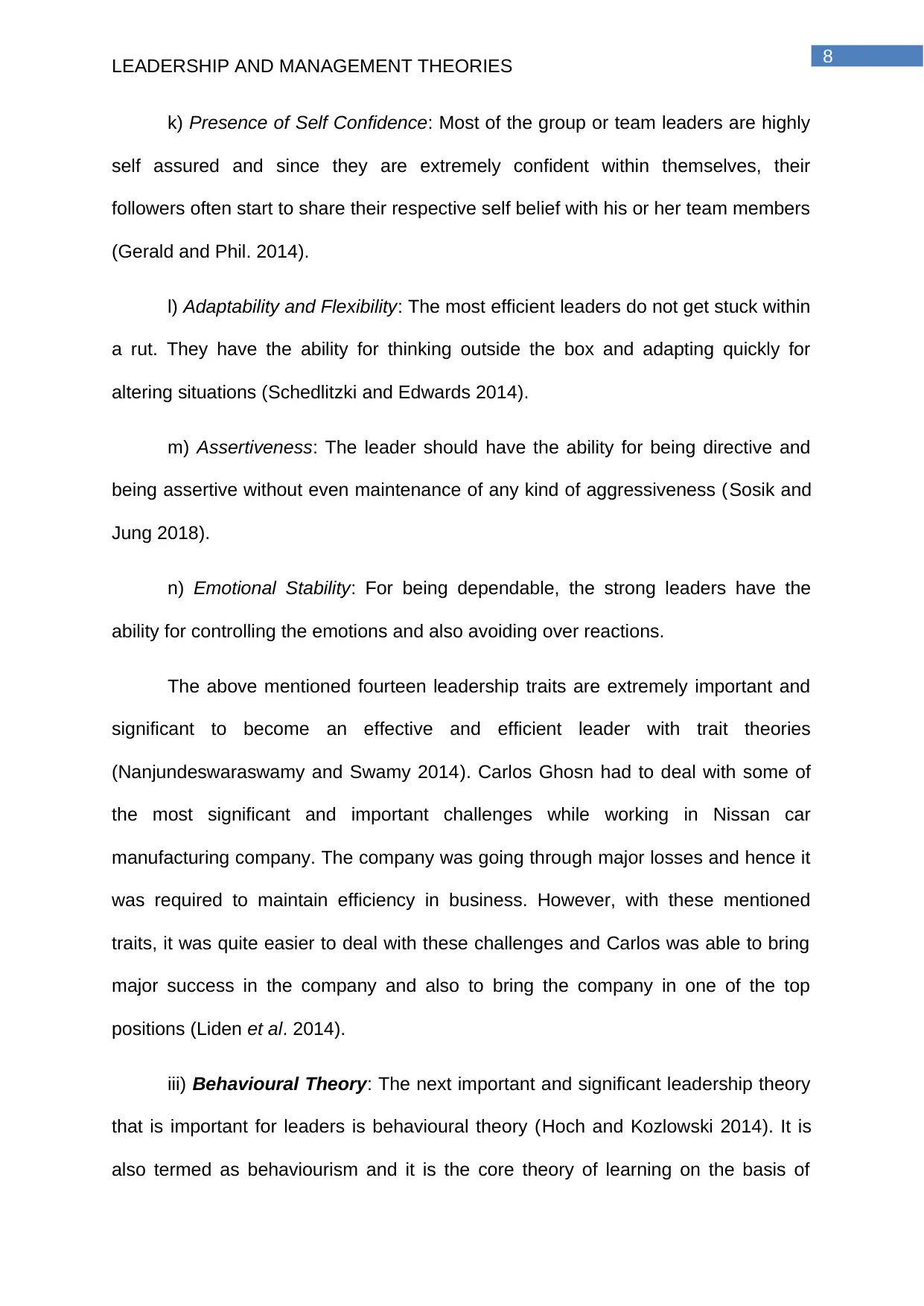
8
LEADERSHIP AND MANAGEMENT THEORIES
k) Presence of Self Confidence: Most of the group or team leaders are highly
self assured and since they are extremely confident within themselves, their
followers often start to share their respective self belief with his or her team members
(Gerald and Phil. 2014).
l) Adaptability and Flexibility: The most efficient leaders do not get stuck within
a rut. They have the ability for thinking outside the box and adapting quickly for
altering situations (Schedlitzki and Edwards 2014).
m) Assertiveness: The leader should have the ability for being directive and
being assertive without even maintenance of any kind of aggressiveness (Sosik and
Jung 2018).
n) Emotional Stability: For being dependable, the strong leaders have the
ability for controlling the emotions and also avoiding over reactions.
The above mentioned fourteen leadership traits are extremely important and
significant to become an effective and efficient leader with trait theories
(Nanjundeswaraswamy and Swamy 2014). Carlos Ghosn had to deal with some of
the most significant and important challenges while working in Nissan car
manufacturing company. The company was going through major losses and hence it
was required to maintain efficiency in business. However, with these mentioned
traits, it was quite easier to deal with these challenges and Carlos was able to bring
major success in the company and also to bring the company in one of the top
positions (Liden et al. 2014).
iii) Behavioural Theory: The next important and significant leadership theory
that is important for leaders is behavioural theory (Hoch and Kozlowski 2014). It is
also termed as behaviourism and it is the core theory of learning on the basis of
LEADERSHIP AND MANAGEMENT THEORIES
k) Presence of Self Confidence: Most of the group or team leaders are highly
self assured and since they are extremely confident within themselves, their
followers often start to share their respective self belief with his or her team members
(Gerald and Phil. 2014).
l) Adaptability and Flexibility: The most efficient leaders do not get stuck within
a rut. They have the ability for thinking outside the box and adapting quickly for
altering situations (Schedlitzki and Edwards 2014).
m) Assertiveness: The leader should have the ability for being directive and
being assertive without even maintenance of any kind of aggressiveness (Sosik and
Jung 2018).
n) Emotional Stability: For being dependable, the strong leaders have the
ability for controlling the emotions and also avoiding over reactions.
The above mentioned fourteen leadership traits are extremely important and
significant to become an effective and efficient leader with trait theories
(Nanjundeswaraswamy and Swamy 2014). Carlos Ghosn had to deal with some of
the most significant and important challenges while working in Nissan car
manufacturing company. The company was going through major losses and hence it
was required to maintain efficiency in business. However, with these mentioned
traits, it was quite easier to deal with these challenges and Carlos was able to bring
major success in the company and also to bring the company in one of the top
positions (Liden et al. 2014).
iii) Behavioural Theory: The next important and significant leadership theory
that is important for leaders is behavioural theory (Hoch and Kozlowski 2014). It is
also termed as behaviourism and it is the core theory of learning on the basis of
⊘ This is a preview!⊘
Do you want full access?
Subscribe today to unlock all pages.

Trusted by 1+ million students worldwide
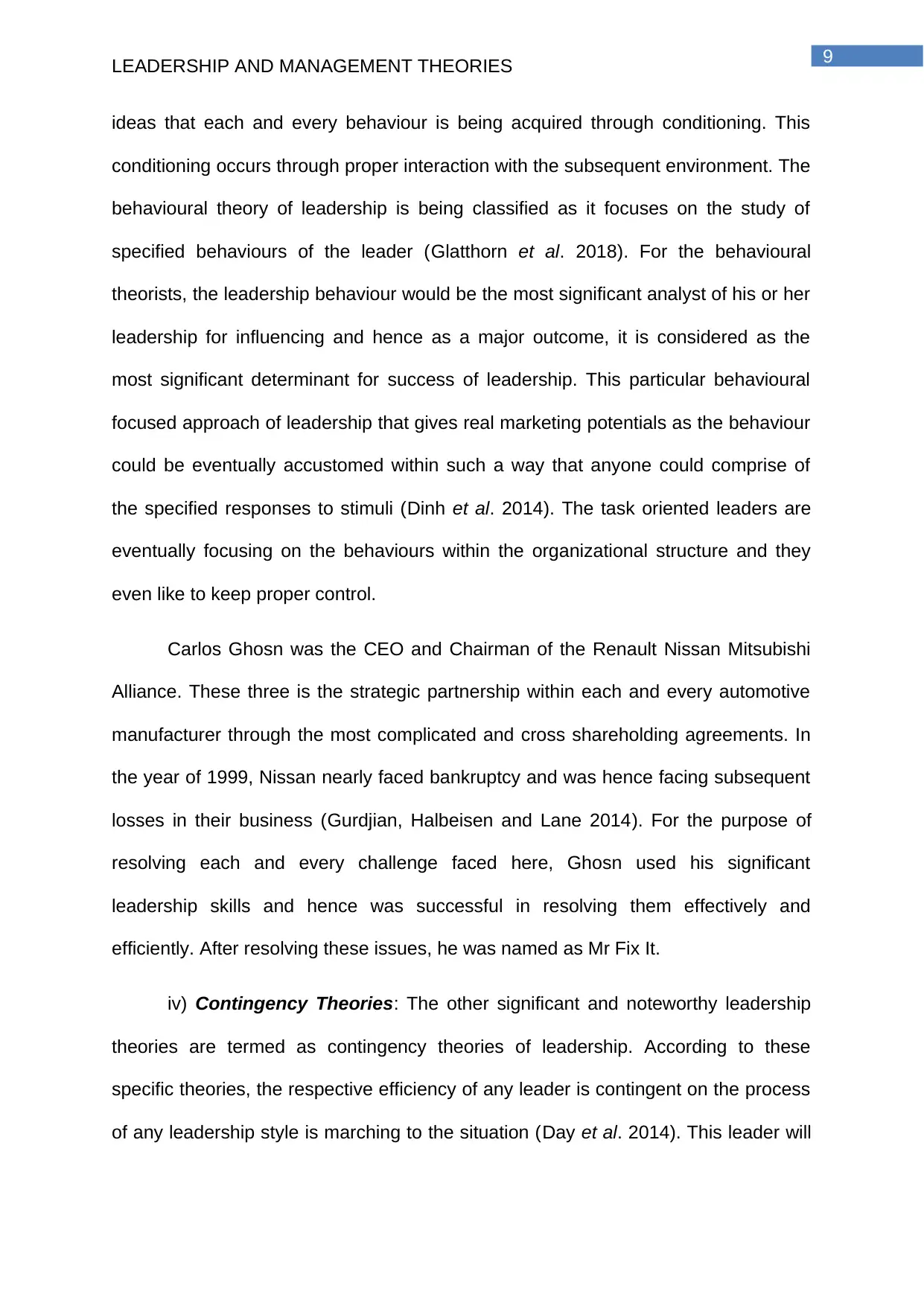
9
LEADERSHIP AND MANAGEMENT THEORIES
ideas that each and every behaviour is being acquired through conditioning. This
conditioning occurs through proper interaction with the subsequent environment. The
behavioural theory of leadership is being classified as it focuses on the study of
specified behaviours of the leader (Glatthorn et al. 2018). For the behavioural
theorists, the leadership behaviour would be the most significant analyst of his or her
leadership for influencing and hence as a major outcome, it is considered as the
most significant determinant for success of leadership. This particular behavioural
focused approach of leadership that gives real marketing potentials as the behaviour
could be eventually accustomed within such a way that anyone could comprise of
the specified responses to stimuli (Dinh et al. 2014). The task oriented leaders are
eventually focusing on the behaviours within the organizational structure and they
even like to keep proper control.
Carlos Ghosn was the CEO and Chairman of the Renault Nissan Mitsubishi
Alliance. These three is the strategic partnership within each and every automotive
manufacturer through the most complicated and cross shareholding agreements. In
the year of 1999, Nissan nearly faced bankruptcy and was hence facing subsequent
losses in their business (Gurdjian, Halbeisen and Lane 2014). For the purpose of
resolving each and every challenge faced here, Ghosn used his significant
leadership skills and hence was successful in resolving them effectively and
efficiently. After resolving these issues, he was named as Mr Fix It.
iv) Contingency Theories: The other significant and noteworthy leadership
theories are termed as contingency theories of leadership. According to these
specific theories, the respective efficiency of any leader is contingent on the process
of any leadership style is marching to the situation (Day et al. 2014). This leader will
LEADERSHIP AND MANAGEMENT THEORIES
ideas that each and every behaviour is being acquired through conditioning. This
conditioning occurs through proper interaction with the subsequent environment. The
behavioural theory of leadership is being classified as it focuses on the study of
specified behaviours of the leader (Glatthorn et al. 2018). For the behavioural
theorists, the leadership behaviour would be the most significant analyst of his or her
leadership for influencing and hence as a major outcome, it is considered as the
most significant determinant for success of leadership. This particular behavioural
focused approach of leadership that gives real marketing potentials as the behaviour
could be eventually accustomed within such a way that anyone could comprise of
the specified responses to stimuli (Dinh et al. 2014). The task oriented leaders are
eventually focusing on the behaviours within the organizational structure and they
even like to keep proper control.
Carlos Ghosn was the CEO and Chairman of the Renault Nissan Mitsubishi
Alliance. These three is the strategic partnership within each and every automotive
manufacturer through the most complicated and cross shareholding agreements. In
the year of 1999, Nissan nearly faced bankruptcy and was hence facing subsequent
losses in their business (Gurdjian, Halbeisen and Lane 2014). For the purpose of
resolving each and every challenge faced here, Ghosn used his significant
leadership skills and hence was successful in resolving them effectively and
efficiently. After resolving these issues, he was named as Mr Fix It.
iv) Contingency Theories: The other significant and noteworthy leadership
theories are termed as contingency theories of leadership. According to these
specific theories, the respective efficiency of any leader is contingent on the process
of any leadership style is marching to the situation (Day et al. 2014). This leader will
Paraphrase This Document
Need a fresh take? Get an instant paraphrase of this document with our AI Paraphraser
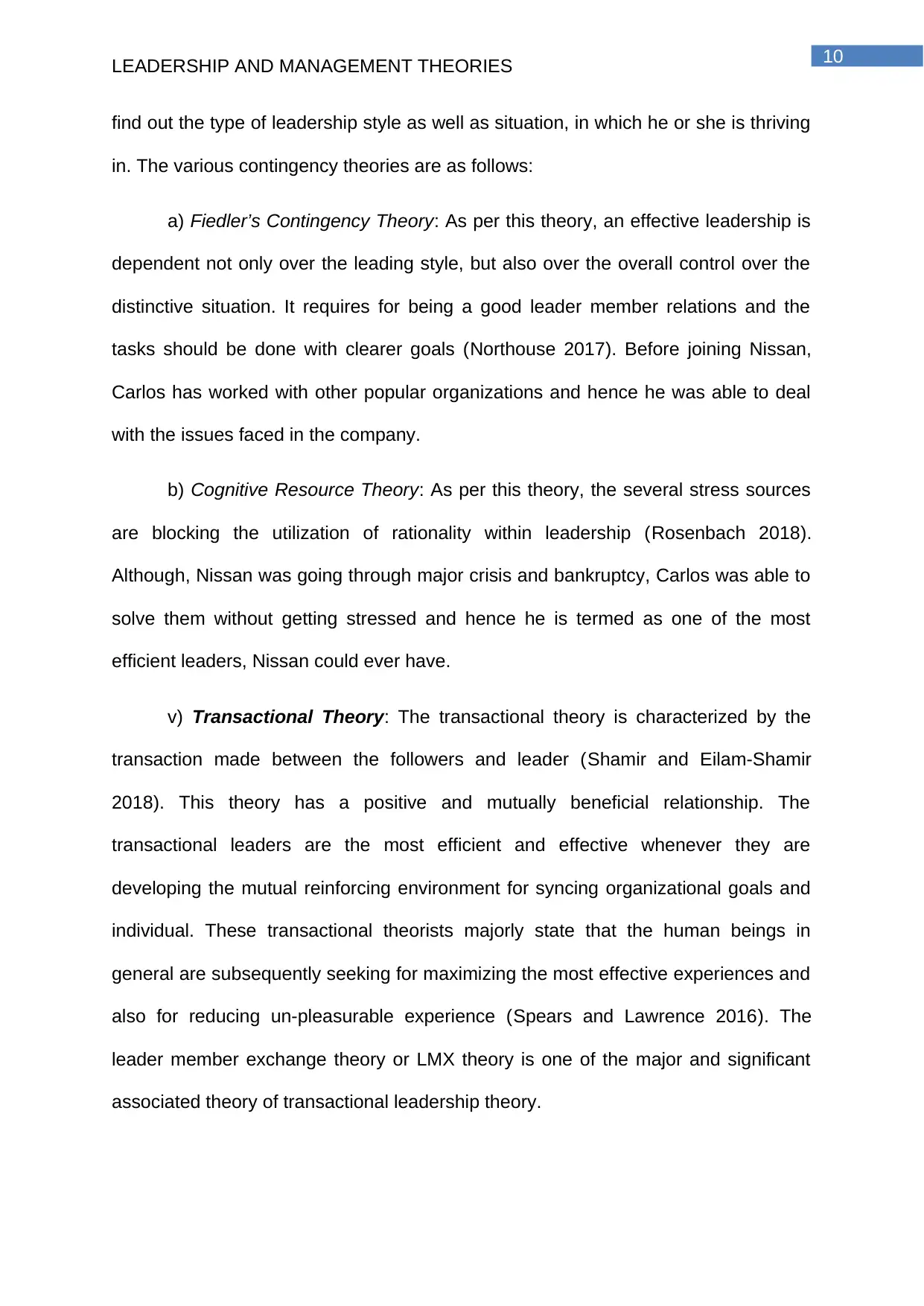
10
LEADERSHIP AND MANAGEMENT THEORIES
find out the type of leadership style as well as situation, in which he or she is thriving
in. The various contingency theories are as follows:
a) Fiedler’s Contingency Theory: As per this theory, an effective leadership is
dependent not only over the leading style, but also over the overall control over the
distinctive situation. It requires for being a good leader member relations and the
tasks should be done with clearer goals (Northouse 2017). Before joining Nissan,
Carlos has worked with other popular organizations and hence he was able to deal
with the issues faced in the company.
b) Cognitive Resource Theory: As per this theory, the several stress sources
are blocking the utilization of rationality within leadership (Rosenbach 2018).
Although, Nissan was going through major crisis and bankruptcy, Carlos was able to
solve them without getting stressed and hence he is termed as one of the most
efficient leaders, Nissan could ever have.
v) Transactional Theory: The transactional theory is characterized by the
transaction made between the followers and leader (Shamir and Eilam-Shamir
2018). This theory has a positive and mutually beneficial relationship. The
transactional leaders are the most efficient and effective whenever they are
developing the mutual reinforcing environment for syncing organizational goals and
individual. These transactional theorists majorly state that the human beings in
general are subsequently seeking for maximizing the most effective experiences and
also for reducing un-pleasurable experience (Spears and Lawrence 2016). The
leader member exchange theory or LMX theory is one of the major and significant
associated theory of transactional leadership theory.
LEADERSHIP AND MANAGEMENT THEORIES
find out the type of leadership style as well as situation, in which he or she is thriving
in. The various contingency theories are as follows:
a) Fiedler’s Contingency Theory: As per this theory, an effective leadership is
dependent not only over the leading style, but also over the overall control over the
distinctive situation. It requires for being a good leader member relations and the
tasks should be done with clearer goals (Northouse 2017). Before joining Nissan,
Carlos has worked with other popular organizations and hence he was able to deal
with the issues faced in the company.
b) Cognitive Resource Theory: As per this theory, the several stress sources
are blocking the utilization of rationality within leadership (Rosenbach 2018).
Although, Nissan was going through major crisis and bankruptcy, Carlos was able to
solve them without getting stressed and hence he is termed as one of the most
efficient leaders, Nissan could ever have.
v) Transactional Theory: The transactional theory is characterized by the
transaction made between the followers and leader (Shamir and Eilam-Shamir
2018). This theory has a positive and mutually beneficial relationship. The
transactional leaders are the most efficient and effective whenever they are
developing the mutual reinforcing environment for syncing organizational goals and
individual. These transactional theorists majorly state that the human beings in
general are subsequently seeking for maximizing the most effective experiences and
also for reducing un-pleasurable experience (Spears and Lawrence 2016). The
leader member exchange theory or LMX theory is one of the major and significant
associated theory of transactional leadership theory.

11
LEADERSHIP AND MANAGEMENT THEORIES
vi) Transformational Theory: The transformational theory states that this is
the process by which any individual can interact with others and has the ability for
creating a major relationship resulting in the higher trust percentage and hence there
is an increase in motivation for both intrinsic and extrinsic for both follower and
leader (Antonakis and House 2014). The rules and regulations are flexible and are
guided by the group principles. Carlos Ghosn in have brought positive changes in
the organization of Nissan and hence have achieved the end goal to develop
followers into leaders. He have even used four distinctive elements of the
transformational leadership of individualized considerations, intellectual stimulations,
and inspirational motivation as well as idealized influences. The respective job
performances of the followers in Nissan through a wide variety of mechanism after
inclusion of linking to the specific sense of identity or even sense of self to the
follower (Schmidt 2014). This is required for inspiring them and also for raising the
interests within project and hence challenging these followers in taking better
ownership for the work. This extremely effective for alignment of followers to
enhance the performances.
The management theories that are effective for the organization of Nissan
Motor Corporation are as follows:
i) Frederick Taylor’s Scientific Management: The first and the foremost
management theory for Nissan case study is Frederick Taylor’s Scientific
Management (Roueche, Baker III and Rose 2014). As per this particular theory of
management, specialization and standardization are required to be managed by
proper suggestion to the fact that work place tasks could be properly broken down
into a wider sequence of small steps. All of these scientific management principles
hence suggest that this particular scientific method for being utilized to effectively
LEADERSHIP AND MANAGEMENT THEORIES
vi) Transformational Theory: The transformational theory states that this is
the process by which any individual can interact with others and has the ability for
creating a major relationship resulting in the higher trust percentage and hence there
is an increase in motivation for both intrinsic and extrinsic for both follower and
leader (Antonakis and House 2014). The rules and regulations are flexible and are
guided by the group principles. Carlos Ghosn in have brought positive changes in
the organization of Nissan and hence have achieved the end goal to develop
followers into leaders. He have even used four distinctive elements of the
transformational leadership of individualized considerations, intellectual stimulations,
and inspirational motivation as well as idealized influences. The respective job
performances of the followers in Nissan through a wide variety of mechanism after
inclusion of linking to the specific sense of identity or even sense of self to the
follower (Schmidt 2014). This is required for inspiring them and also for raising the
interests within project and hence challenging these followers in taking better
ownership for the work. This extremely effective for alignment of followers to
enhance the performances.
The management theories that are effective for the organization of Nissan
Motor Corporation are as follows:
i) Frederick Taylor’s Scientific Management: The first and the foremost
management theory for Nissan case study is Frederick Taylor’s Scientific
Management (Roueche, Baker III and Rose 2014). As per this particular theory of
management, specialization and standardization are required to be managed by
proper suggestion to the fact that work place tasks could be properly broken down
into a wider sequence of small steps. All of these scientific management principles
hence suggest that this particular scientific method for being utilized to effectively
⊘ This is a preview!⊘
Do you want full access?
Subscribe today to unlock all pages.

Trusted by 1+ million students worldwide
1 out of 30
Related Documents
Your All-in-One AI-Powered Toolkit for Academic Success.
+13062052269
info@desklib.com
Available 24*7 on WhatsApp / Email
![[object Object]](/_next/static/media/star-bottom.7253800d.svg)
Unlock your academic potential
Copyright © 2020–2025 A2Z Services. All Rights Reserved. Developed and managed by ZUCOL.





